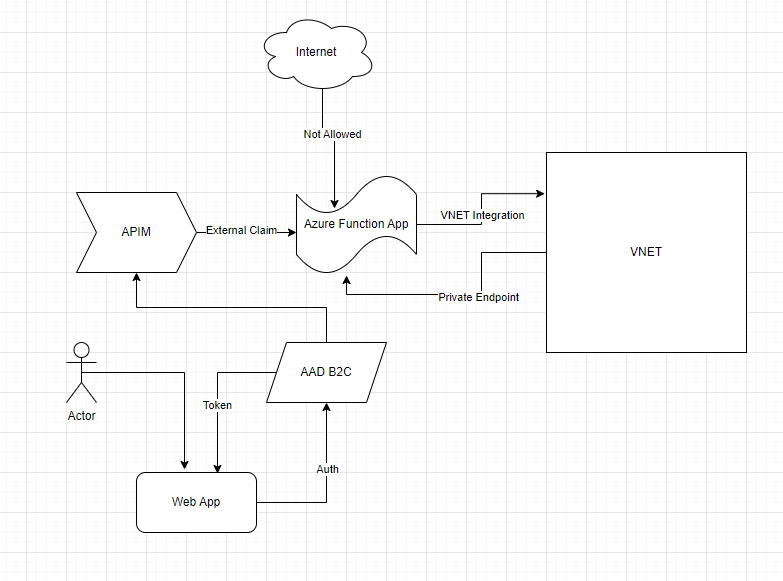Securing Azure AD B2C API Connector (Function App) without Error

I was recently working with a customer who is using Azure AD B2C API Connector to enrich tokens with claims from external sources. They are using Azure Function App as the external source. As this setup demands, they exposed Azure Function App over public IP to work with B2C. But due to enterprise security restriction policy they must remove public endpoint from Function App and use private endpoints to VNET.
They thought of 2 options to expose the Function App securely over internet – using Azure API Management instance to a virtual network - external mode APIM in external mode or using Azure Application Gateway. But in both the cases B2C auth process errors out after adding the API Connector in the user flow:
Initially I investigated on the error messages collected at the B2C, and APIM or Azure Application Gateway end. But later realized the main source of problem lies somewhere else. It is the ASP.NET Core framework used in building the Function App.
We need to modify default FowardedHeaders middleware settings. Otherwise, it will ignore the X-Forwarded headers being sent by APIM or Application Gateway because it isn’t in the list of KnownProxies and KnownNetworks. Please see the following links to understand the concept better:
- Configure ASP.NET Core to work with proxy servers and load balancers | Microsoft Learn
- Using Azure Front Door with .NET Core • Jamie Phillips (phillipsj.net)
So, I did the following changes:
1. Added ASPNETCORE_FORWARDEDHEADERS_ENABLED application setting to my Function App Configuration:
2. Added a Startup.cs file in my function app code.
using System.Collections.Generic;
using Microsoft.AspNetCore.Builder;
using Microsoft.Azure.Functions.Extensions.DependencyInjection;
using Microsoft.Extensions.DependencyInjection;
[assembly: FunctionsStartup(typeof(TestAPIFunctionApp.Startup))]
namespace TestAPIFunctionApp
{
public class Startup : FunctionsStartup
{
public override void Configure(IFunctionsHostBuilder builder)
{
builder.Services.Configure<ForwardedHeadersOptions>(options =>
{
options.ForwardedHeaders = Microsoft.AspNetCore.HttpOverrides.ForwardedHeaders.XForwardedFor | Microsoft.AspNetCore.HttpOverrides.ForwardedHeaders.XForwardedProto | Microsoft.AspNetCore.HttpOverrides.ForwardedHeaders.XForwardedHost;
options.KnownNetworks.Clear();
options.KnownProxies.Clear();
// Put your front door, application gateway, APIM, b2clogin FQDN here and any other hosts that will send headers you want respected
options.AllowedHosts = new List<string>() { "<yourfunctionappname>.azurewebsites.net", "<yourb2cservicename>.b2clogin.com", "<yourAPIMservicename>.azure-api.net”};
});
}
}
}
That solves our problem. We can now see the “augmented claims”:
Published on:
Learn moreRelated posts
Automating Business PDFs Using Azure Document Intelligence and Power Automate
In today’s data-driven enterprises, critical business information often arrives in the form of PDFs—bank statements, invoices, policy document...
Azure Developer CLI (azd) Dec 2025 – Extensions Enhancements, Foundry Rebranding, and Azure Pipelines Improvements
This post announces the December release of the Azure Developer CLI (`azd`). The post Azure Developer CLI (azd) Dec 2025 – Extensions En...
Unlock the power of distributed graph databases with JanusGraph and Azure Apache Cassandra
Connecting the Dots: How Graph Databases Drive Innovation In today’s data-rich world, organizations face challenges that go beyond simple tabl...
Azure Boards integration with GitHub Copilot
A few months ago we introduced the Azure Boards integration with GitHub Copilot in private preview. The goal was simple: allow teams to take a...
Microsoft Dataverse – Monitor batch workloads with Azure Monitor Application Insights
We are announcing the ability to monitor batch workload telemetry in Azure Monitor Application Insights for finance and operations apps in Mic...
Copilot Studio: Connect An Azure SQL Database As Knowledge
Copilot Studio can connect to an Azure SQL database and use its structured data as ... The post Copilot Studio: Connect An Azure SQL Database ...
Retirement of Global Personal Access Tokens in Azure DevOps
In the new year, we’ll be retiring the Global Personal Access Token (PAT) type in Azure DevOps. Global PATs allow users to authenticate across...
Azure Cosmos DB vNext Emulator: Query and Observability Enhancements
The Azure Cosmos DB Linux-based vNext emulator (preview) is a local version of the Azure Cosmos DB service that runs as a Docker container on ...



